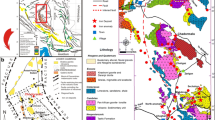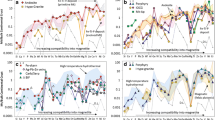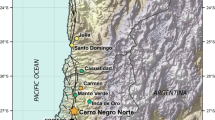Abstract
Magnetite from hydrothermal ore deposits can contain up to tens of thousands of parts per million (ppm) of elements such as Ti, Si, V, Al, Ca, Mg, Na, which tend to either structurally incorporate into growth and sector zones or form mineral micro- to nano-sized particles. Here, we report micro- to nano-structural and chemical data of hydrothermal magnetite from the Los Colorados iron oxide–apatite deposit in Chile, where magnetite displays both types of trace element incorporation. Three generations of magnetites (X–Z) were identified with concentrations of minor and trace elements that vary significantly: SiO2, from below detection limit (bdl) to 3.1 wt%; Al2O3, 0.3–2.3 wt%; CaO, bdl–0.9 wt%; MgO, 0.02–2.5 wt%; TiO2, 0.1–0.4 wt%; MnO, 0.04–0.2 wt%; Na2O, bdl–0.4 wt%; and K2O, bdl–0.4 wt%. An exception is V2O3, which is remarkably constant, ranging from 0.3 to 0.4 wt%. Six types of crystalline nanoparticles (NPs) were identified by means of transmission electron microscopy in the trace element-rich zones, which are each a few micrometres wide: (1) diopside, (2) clinoenstatite; (3) amphibole, (4) mica, (5) ulvöspinel, and (6) Ti-rich magnetite. In addition, Al-rich nanodomains, which contain 2–3 wt% of Al, occur within a single crystal of magnetite. The accumulation of NPs in the trace element-rich zones suggest that they form owing to supersaturation from a hydrothermal fluid, followed by entrapment during continuous growth of the magnetite surface. It is also concluded that mineral NPs promote exsolution of new phases from the mineral host, otherwise preserved as structurally bound trace elements. The presence of abundant mineral NPs in magnetite points to a complex incorporation of trace elements during growth, and provides a cautionary note on the interpretation of micron-scale chemical data of magnetite.









Similar content being viewed by others
References
Arato R, Audetat A (2016) Experimental calibration of a new oxybarometer for silicic magmas based on vanadium partitioning between magnetite and silicate melt. Geochim Cosmochim Acta 209:284–295
Arato R, Audetat A (2017) Vanadium magnetite-melt oxybarometry of natural, silicic magmas: a comparison of various oxybarometers and thermometers. Contrib Miner Petrol 172:52
Armstrong JT (1988) Quantitative analysis of silicates and oxide minerals: Comparison of Monte-Carlo, ZAF, and Phi-Rho-Z procedures. Microbeam Analysis, pp 239–246
Bilenker LD, Simon AC, Reich M, Lundstrom CC, Gajos N, Bindeman I, Barra F, Munizaga R (2016) Fe–O stable isotope pairs elucidate a high-temperature origin of Chilean iron oxide-apatite deposits. Geochim Cosmochim Acta 177:94–104
Bosi F, Hålenius U, Skogby H (2009) Crystal chemistry of the magnetite-ulvöspinel series. Am Mineral 94:181–189
Boutroy E, Dare SAS, Beaudoin G, Barnes S-J, Lightfoot P (2014) Magnetite composition in Ni–Cu–PGE deposits worldwide: application to mineral exploration. J Geochem Exp 145:64–81
Buddington AF, Lindsley DH (1964) Iron-titanium oxide minerals and synthetic equivalents. J Petrol 5:310–357
Charlier B, Namur O, Bolle O, Latypov R, Duchesne J-C (2015) Fe–Ti–V ore deposits associated with Proterozoic massif-type anorthosites and related rocks. Earth Sci Rev 141:56–81
Ciobanu CL, Cook NJ, Utsunomiya S, Pring A, Green L (2011) Focussed ion beam-transmission electron microscopy applications in ore mineralogy: bridging micro-and nanoscale observations. Ore Geol Rev 42:6–31
Colás V, Padrón-Navarta JA, González-Jiménez J-M, Griffin WL, Fanlo I, O’Reilly SY, Geervilla F, Proenza JA, Pearson NJ, Escayola MP (2015) Compositional effects on the solubility of minor and trace elements in oxide spinel minerals: insights from crystal-chemical partition coefficients in chromite exsolution. Am Mineral 101:1360–1372
Connoly HC Jr, Burnett DS (2003) On type B CAI formation: experimental constraints on fO2 variations in spinel minor element partitioning and reequilibration. Geochim Cosmochim Acta 67:4429–4434
Dare SAS, Barnes S-J, Beaudoin G (2012) Variation in trace element content of magnetite crystallized from a fractionating sulphide liquid, Sudbury, Canada: Implications for provenance discrimination. Geochim Cosmochim Acta 88:27–50
Dare SAS, Barnes S-J, Beaudoin G, Méric J, Boutroy E, Potvin-Doucet C (2014) Trace elements in magnetite as petrogenetic indicators. Miner Dep 49:785–796
Dare SAS, Barnes S-J, Beaudoin G (2015) Did the massive magnetite “lava flows” of El Laco (Chile) form by magmatic or hydrothermal processes? New constraints from magnetite composition by LA-ICP-MS. Miner Dep 5:607–617
Davis KJ, Dove PM, De Yoreo JJ (2000) The role of Mg2+ as an impurity in calcite growth. Science 290:1134–1137
Deditius AP, Utsunomiya S, Ewing RC, Chryssoulis SL, Venter D, Kesler SE (2009) Decoupled geochemical behaviour of As and Cu in hydrothermal systems. Geology 37:707–710
Deditius AP, Kesler SE, Utsunomiya S, Reich M, Ewing RC (2011) Structural and chemical discontinuities in pyrite. Let’s talk of ore deposits, vols I and II, pp 258–260
Dobrzhinetskaya LF, Wirth R, Rhede D, Liu Z, Green HW (2009) Phlogopite and quartz lamellae in diamond-bearing diopside from marbles of the Kokchetav massif, Kazakhstan: exsolution or replacement reaction? J Metamorph Geol 27:607–620
Donovan JJ, Tingle TN (1996) An improved mean atomic number correction for quantitative microanalysis. J Microsc 2:1–7
Donovan JJ, Snyder DA, Rivers ML (1993) An improved interference correction for trace element analysis. Microbeam Anal 2:23–28
Donovan JJ, Singer JW, Armstrong JT (2016) A new method for fast trace element analysis in simple matrices. Am Mineral 101:1839–1853
Dupuis C, Beaudoin G (2011) Discrimination diagrams for iron oxide trace element fingerprinting of mineral deposit types. Miner Dep 46:319–335
Gaspar JC, Wyllie PJ (1983) Magnetite in carbonates from the Jacupiranga Complex, Brazil. Am Mineral 68:195–213
Goldschmidt VM (1954) Geochemistry. Oxford University Press, Oxford
Golla-Schindler U, O’Neill HSC, Putnis A (2005) Direct observation of spinodal decomposition in the magnetite-hercynite system by susceptibility measurements and transmission electron microscopy. Am Mineral 90:1278–1283
Günther T, Klemd R, Zhang X, Horn I, Weyer S (2017) In-situ trace element and Fe-isotope studies on magnetite of the volcanic-hosted Zhibo and Chagangnuoer iron ore deposits in the Western Tianshan, NW China. Chem Geol 453:111–127
Guzmics T, Mitchell RH, Szabó C, Berkesi M, Milke R, Abart R (2011) Carbonatite melt inclusions in coexisting magnetite, apatite and monticellite in Kerimasi calciocarbonatite, Tanzania: melt evolution and petrogenesis. Contrib Mineral Petrol 161:177–196
Haggarty SE (2016) Spinel in planetary systems. Am Mineral 101:5–6
Harrison R, Dunin-Borkowski RE, Putnis A (2002) Direct imaging of nanoscale magnetic interactions in minerals. PNAS 99:16556–16561
Heidarian H, Lentz D, Alirazaei S, Peighambari S, Hall D (2016) Using the chemical analysis of magnetite to constrain various stages in the formation and genesis of the Kiruna–type Chadormalu magnetite-apatite deposit, Bafq district, Central Iran. Mineral Petrol 110:927–942
Henderson CMB, Pearce CI, Charnock JM, Harrison RJ, Rosso KM (2016) An X-ray magnetic circular dichroism (XMCD) study of Fe ordering in a synthetic MgAl2O4–Fe3O4 (spinel-magnetite) solid solution series: Implications for magnetic properties and cation site ordering. Am Mineral 100:1373–1388
Hu H, Lentz D, Li L-W, McCarron T, Zhao X-F, Hall D (2014a) Reequilibration processes in magnetite from iron skarn deposits. Econ Geol 110:1–8
Hu H, Li L-W, Lentz D, Ren Z, Zhao X-F, Deng X-D, Hall D (2014b) Dissolution-reprecipitation process of magnetite from the Chengchao iron deposit: Insights into ore genesis and implication for in-situ chemical analysis of magnetite. Ore Geol Rev 57:393–405
Huberty JM, Konishi H, Heck PR, Fournelle JH, Valley JW, Xu H (2012) Silician magnetite from the Dales Gorge Member of the Brockman Iron Formation, Hamersley Group, Western Australia. Am Mineral 97:26–37
Ilton ES, Eugster HP (1990) Partitioning of base metals between silicates, oxides, and chloride-rich hydrothermal fluid: part I. Evaluation of data derived from experimental and natural assemblages. In: Spencer RJ, Chou I-M (eds) Fluid mineral interaction: a tribute to H.P. Eugster. The geochemical Society, Special Publications, No. 2, pp 157–169
Klemm DD, Von Grunewaldt G, Henckel J, Dehm R (1985) The geochemistry of titanomagnetite in magnetite layers and their host rocks. Econ Geol 80:1075–1088
Knipping JL, Bilkner LD, Simon AC, Reich M, Barra F, Deditius AP, Lundstrom C, Wälle M, Heinrich CA, Holtz F, Munizaga R (2015a) Trace element distribution in magnetite as key to a new magmatic-hydrothermal model for Kiruna-type iron oxide-apatite deposits. Geochim Cosmochim Acta 171:15–38
Knipping JL, Bilkner LD, Simon AC, Reich M, Barra F, Deditius AP, Lundstrom C, Bindeman I, Munizaga R (2015b) Giant Kiruna-type deposits form by efficient aggregation of magmatic magnetite suspensions. Geology 43:591–594
Kouchi A, Sugawara Y, Kashima K, Sunagawa I (1983) Laboratory growth of sector zoned clinopyroxenes in the system CaMgSi2O6-CaTiAl2O6. Contrib Mineral Petrol 83:177–184
Liu P-P, Zhou M-F, Chen WT, Boone M, Cnudde V (2014) Using multiphase solid inclusions to constrain the origin of the Baima Fe–Ti–(V) oxide deposit, SW China. J Petrol 55:951–976
Nadoll P, Mauk JL, Hayes TS, Koenig AE, Box SE (2012) Geochemistry of magnetite from hydrothermal ore deposits and host rocks of Mesoproterozoic Belt Supergroup, United States. Econ Geol 107:1275–1292
Nadoll P, Angerrer T, Mauk JL, French D, Walshe J (2014) The chemistry of hydrothermal magnetite: a review. Ore Geol Rev 61:1–32
Nadoll P, Mauk JL, Hayes TS, Koenig AE, Box SE (2017) Element partitioning in magnetite under low-grade metamorphic conditions—a case study from the Proterozoic Belt Supergroup, USA. Eur J Mineral 29:795–805
Neumann E-R, Svensen HH, Polozov AZ, Hammer Ø (2017) Formation of Si-Al-Mg-Ca-rich zoned magnetite and end-Permian phretomagmatic pipe in the Tunguska Basin, East Siberia. Miner Dep. https://doi.org/10.1007/s00126-017-0717-9
Newberry NG, Peacor DR, Essene EJ, Geissman JW (1982) Silicon in magnetite: high resolution microanalysis of magnetite-ilmenite intergrowths. Contrib Mineral Petrol 80:334–340
Papike JJ, Purger PV, Bell AS, Shearer CK, Le L, Jones J (2015) Normal to inverse transition in martian spinel: understanding the interplay between chromium, vanadium, and iron valence state partitioning through a crystal-chemical lens. Am Mineral 100:2018–2025
Price GD (1981) Subsolidus phase relations in the titanomagnetite solid solution series. Am Mineral 66:751–758
Putnis A (2009) Mineral replacement reactions. Rev Mineral Geochem 70:87–124
Putnis A, Fernandez-Diaz L, Prieto M (1992) Experimentally produced oscillatory zoning in the (Ba,Sr)SO4 solid solution. Nature 358:743–745
Reguir EP, Chakhmouradian AR, Halden NM, Yang P, Zaitsev AN (2008) Early magmatic and reaction induced trends in magnetite from the carbonatites of Kerimasi, Tanzania. Can Mineral 46:879–900
Reich M, Deditius A, Chryssoulis S, Li J-W, Ma C-Q, Parada MA, Barra F, Mittermayr F (2013) Pyrite as a record of hydrothermal fluid evolution in a porphyry copper system: a SIMS/EPMA trace element study. Geochem Cosmochim Acta 104:42–62
Reich M, Simon AC, Deditius A, Barra F, Chryssoulis S, Lagas G, Tardani D, Knipping J, Bilenker L, Sánchez-Alfaro P, Roberts MP, Munizaga R (2016) Trace element signature of pyrite from the Los Colorados iron oxide-apatite (IOA) deposit, Chile: a missing link between Andean IOA and IOCG systems? Econ Geol 111:743–761
Rodgers DR, Arnott RJ, Wold A, Goodenough JB (1963) The preparation and properties of some vanadium spinels. Phys Chem Solids 24:347–360
Shore M, Fowler AD (1996) Oscillatory zoning in minerals: a common phenomenon. Can Mineral 34:1111–1126
Shtuckenberg AG, Punin YO, Artamova OI (2009) Effect of crystal composition and growth rate on sector zoning in solid solutions grown from aqueous solutions. Mineral Mag 73:385–398
Sievwright RH, Wilkinson JJ, O’Neil HSC, Berry AJ (2017) Thermodynamic controls on element partitioning between titanomagnetite and andesitic–dacitic silicate melts. Contrib Mineral Petrol 172:62
Sitzman SD, Banfield JF, Valley JW (2000) Microstructural characterization of metamorphic magnetite crystals with implications for oxygen isotope distribution. Am Mineral 85:14–21
Sossi PA, Prytulak J, O’Neill HSC (2018) Experimental calibration of vanadium partitioning and stable isotopes fractionation between hydrous granitic melt and magnetite at 800 °C and 0.5 GPa. Contrib Mineral Petrol 173:27
Stowell H, Zuluaga C, Boyle A, Bulman G (2011) Garnet sector and oscillatory zoning linked with changes in crystal morphology during rapid growth, North Cascades, Washington. Am Mineral 96:1354–1362
Tardani D, Reich M, Deditius AP, Chryssoulis S, Sánchez-Alfaro P, Wrage J (2017) Cu–As decoupling in an active geothermal system: a link between pyrite and fluid composition. Geochim Cosmochim Acta, 204:179–204
Tauson VL, Smagunov NV, Lipko SV (2017) Cocrystallization coefficients of Cr, V, and Fe in hydrothermal ore systems (from experimental data). Russ Geol Geophys 58:949–955
Toplis M, Corgne A (2002) An experimental study of element partitioning between magnetite, clinopyroxene and iron-bearing silicate liquid with particular emphasis on vanadium. Contrib Mineral Petrol 144:22–27
Utsunomiya S, Ewing RC (2003) Application of high-angle annular dark field scanning transmission microscopy, scanning transmission electron microscope-energy dispersive X-ray spectrometry, and energy-filtered transmission electron microscopy to the characterization of nanoparticles in the environment. Environ Sci Technol 37:786–791
Velasco F, Tornos F, Hanchar FM (2016) Immiscible iron- and silica-rich melts and magnetite geochemistry at the El Laco volcano (northern Chile): evidence for a magmatic origin for the magnetite deposits. Ore Geol Rev 79:346–366
von Grunewaldt G, Klemm DD, Henckel J, Dehm RM (1985) Exsolution features in titanomagnetite from massive magnetite layers and their host rocks of the Upper Zone, Eastern Bushveld Complex. Econ Geol 80:1049–1061
Wang YG, Ye HQ, Ximen LL, Kuo KH (1989) A HRTEM study of the intergrowth of magnetite and coulsonite. Acta Crystallogr A45:264–268
Watson EB (1996) Surface enrichment and trace-element uptake during crystal growth. Geochim Cosmochim Acta 60:5013–5020
Watson EB (2004) A conceptual model for near-surface kinetic controls on the trace-element and stable isotope composition of abiogenic calcite crystals. Geochim Cosmochim Acta 68:1473–1488
Watson EB, Liang Y (1995) A simple model for sector zoning in slowly grown crystals: implications for growth rate and lattice diffusion, with emphasis pm accessory minerals in crystal rocks. Am Mineral 80:1179–1187
Weinbruch S, Styrsa V, Müller WF (2003) Exsolution and coarsening in iron-free clinopyroxene during isothermal annealing. Geochim Cosmochim Acta 67:5071–5082
Xie Q, Zhang Z, Hou T, Jin Z, Santosh M (2017) Geochemistry and oxygen isotope composition of magnetite from the Zhangmatun deposit, North China: Implications for the magmatic-hydrothermal evolution of Cornwall-type iron mineralization. Ore Geol Rev 88:57–70
Xu H, Shen Z, Konishi H (2014) Si-magnetite nano-precipitates in silician magnetite from banded iron formation: Z-contrast imaging and ab initio study. Am Mineral 99:2196–2202
Yang Y-L, Ni P, Wang G-G, Xu Y-F (2017) Constraints on the mineralization processes of the Makeng iron deposit, eastern China: fluid inclusion, H-O isotope and magnetite trace element analysis. Ore Geol Rev 88:791–808
Zhao WW, Zhou M-F (2015) In-situ LA-ICP-MS trace elemental analysis of magnetite: the Mesozoic Tengite skarn Fe deposit in the Nanling Range, South China. Ore Geol Rev 65:872–883
Acknowledgements
Martin Reich acknowledges funding from MSI Millennium Nucleus for Metal Tracing Along Subduction (NC130065). The authors acknowledge the facilities, and the scientific and technical assistance of the Australian Microscopy and Microanalysis Research Facility at the Centre for Microscopy, Characterisation and Analysis, The University of Western Australia, a facility funded by the University, and by State and Commonwealth Governments. The comments from Jeffrey L. Mauk, Patrick Nadoll, and Othmar Münthener greatly improved the quality of the manuscript.
Author information
Authors and Affiliations
Corresponding author
Additional information
Communicated by Othmar Müntener.
Electronic supplementary material
Below is the link to the electronic supplementary material.
Rights and permissions
About this article
Cite this article
Deditius, A.P., Reich, M., Simon, A.C. et al. Nanogeochemistry of hydrothermal magnetite. Contrib Mineral Petrol 173, 46 (2018). https://doi.org/10.1007/s00410-018-1474-1
Received:
Accepted:
Published:
DOI: https://doi.org/10.1007/s00410-018-1474-1




